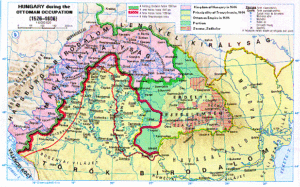The Hussars ambush the fair of Hatvan in 1580

The “Small War” on the Borderland
Military actions between the Ottoman Empire and the Kingdom of Hungary have been going on since the first decades of the 15th century until at least 1699. The 1,000-mile-long and 10-100-mile-wide Borderland was a perfect place for ambushes, raids, and hit-and-run actions: it was the cradle where the Hussar cavalry was born.

As for the Ottomans, their military strategy was to “soften up” the enemy’s lands as far as they could: they destroyed the villages that were supporting the Hungarian and Croatian castles with food and spread terror deep behind the Borderland, too. It was the way of life between the “official wars” and this “small war” was considered normal unless artillery and siege engines were applied.

However, the quick Ottoman units were received by Hungarian warriors who had once been horse-archers themselves and hadn’t forgotten all of their horsemanship just yet. The Hungarians’ military success in Central Europe derived from the flexible use of both Western and Eastern warfare. They were faster than western cavalry but heavier than eastern riders. Read more about these horses here:
https://www.hungarianottomanwars.com/essays/horses-of-battle/
The Borderland was made up of a chain of castles and fortified places where the rate of Hussar cavalry and infantry was 1:1. The Turks could be beaten only by endless counter-raids and ambushes, long patrols deep behind the “Turk” lines, plundering lands that were actually inhabited still by Christian Hungarians or Slavs. As the contemporary saying went, “The castle can be defended only in the field” which meant aggressive warfare.

The problem was always the money, of course. While the Imperial Western mercenaries were more or less regularly paid (and their pay was twice higher than the local soldiers’), the castle warriors and Hussars received their pay (or just a fragment of it) just months or even years later. They either starved and sold their weapons or took up jobs, cultivated a vinery or the lands. However, many decided not to work as it was “below them” and they were raiding the countryside, in better cases the enemy’s lands (which were inhabited by Christians, anyway).

The Borderland warriors considered themselves members of the Valiant Order and they had a certain unwritten code of honor that stopped them from selling their swords to the enemy, though. Ransoming high-ranking Ottoman officers was a major income, the source of survival in many cases. It was why there were so many duels, too. Capturing the Ottomans’ tax collectors who mainly belonged to the members of the Jewish community was also an effective way of making money.

However, perhaps the best business was the “hitting of a fair”. Fairs were regularly held in Hungarian market towns which were the centers of the surrounding areas. Plenty of animals were herded to these fairs and merchants arrived with hundreds of wagonloads of products. No wonder, that they were heavily guarded by the Turks. To them, a fair was an ideal place where they were able to collect their taxes. Hatvan was such a town like this; you can read more about this fortified Borderland town that happened to belong to the Ottomans in 1580:
https://www.hungarianottomanwars.com/ottoman-occupied-lands/hatvan/
The ambush of Hatvan on 21 April 1580
The endeavor seemed to have been organized well by the Hungarian Borderland warrior. It must have been kept in deep secret, unlike many similar actions. Also, the enemy’s attention had to be distracted. During the middle of April, the riders of Nádasdy Ferenc were raiding the area of Esztergom while the Hussars of Kanizsa castle were doing the same at Berzence castle. The cavalrymen of Upper Hungary were spreading havoc around Kékkő castle. Here is more about Kékkő castle, the ancient nest of the Balassi family:
https://www.hungarianottomanwars.com/kingdom-of-hungary/kekko/

The soldiers who attacked Hatvan were coming from the Hungarian Borderland castles of Eger, Diósgyőr, Tokaj, Cserépvár, and other castles in the area. We are lucky that the story of the case was written in the “Historia cladis Turcicae ad Nadudvar” which was a contemporary poetic work. Thus we know that Captain Karl Rueber of Tokaj castle (and not his elder brother, Captain Hans Rueber of Kassa castle) and the Hungarian warrior-poet, Balassi Bálint were involved, too. Balassi used to be a cavalry lieutenant from Eger castle at this time.



https://www.hungarianottomanwars.com/essays/bey-sasvar-the-renegade/
Bey Sásvár had a big role in removing Pasha Üvejsz and it was Sásvár who acted as a caimacam, the substitute of the pasha, who was directing the Vilayet of Buda until Ali arrived. Sásvár had been aspiring for the position of the pasha in secret, though.

Dear Readers, I can only make this content available through small donations or by selling my books or T-shirts.
If you like my writings, please feel free to support me with a coffee here:
You can check out my books on Amazon or Draft2Digital, they are available in hardcover, paperback, or ebook:
https://www.amazon.com/dp/198020490X
or at https://books2read.com/b/boYd81


My work can also be followed and supported on Patreon: Become a Patron!http://Become a Patron!


https://hungarianottomanwars.myspreadshop.com/

https://hungarianottomanwars.myspreadshop.com/all


